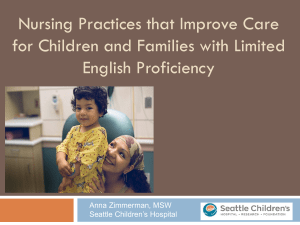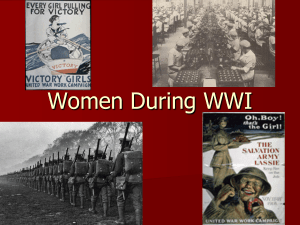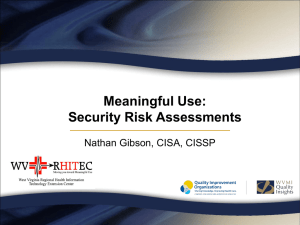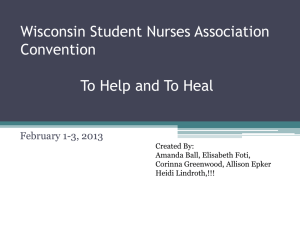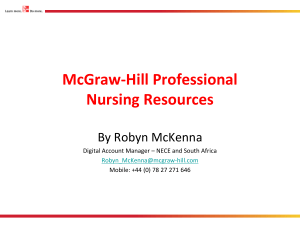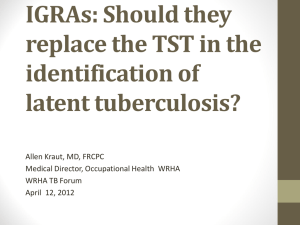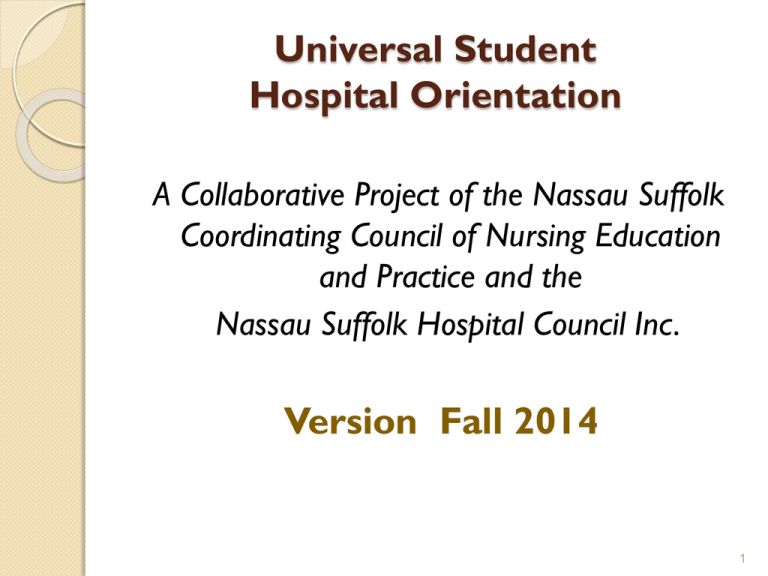
Universal Student
Hospital Orientation
A Collaborative Project of the Nassau Suffolk
Coordinating Council of Nursing Education
and Practice and the
Nassau Suffolk Hospital Council Inc.
Version Fall 2014
1
Introduction
This presentation is to be viewed by all student
nurses in advance of beginning their clinical
rotation annually.
It in no way replaces the site specific
information that will be covered by faculty and
or institutional personnel upon arrival in the
institution.
Each school will send a letter to the individual
hospitals they are using for student rotation
attesting to the fact that the students have
completed the program and scored an 80 or
better on the post-test.
2
Topic Outline
Asepsis/Infection Prevention
Culture
Environmental/Fire Safety
HIPAA/Confidentiality
Quality and Safety
National Patient Safety Goals
◦
◦
◦
◦
Medications
Communication
Environment
Patient Rights
3
Program Objectives
1. Identify ways to prevent or minimize workplace
injuries or illness.
2. Describe role in relation to general safety in the
workplace including fire safety and security.
3. Verbalize value of teamwork and collaboration.
4. Follow and enforce hand hygiene procedures.
5. Demonstrate behaviors that illustrate cultural
competence.
6. Identify at least two patient safety goals related
to areas of responsibility.
7. Describe role in relation to HIPAA regulations.
4
Service Excellence
As a student you are expected to demonstrate, at all times, behaviors and
attributes that support the standards of Service Excellence. Examples of WE
behaviors to be demonstrated when working with patients, families, visitors,
physicians and colleagues in any organization:
Working Together:
Be helpful and informative.
Respond to call bells.
If you are unable to assist, find someone who can.
Look beyond your assigned tasks, your responsibilities do not end where your
co-workers’ responsibilities begin.
Never say “That’s not my job.”
Empathy:
Be compassionate and considerate at all times.
Recognize and appreciate the feelings of others. Apologize and express
concern anytime an individual is not satisfied.
5
Service Excellence (continued)
One technique for service breakdowns which a result
from misunderstandings, poor service skills, faulty
policies or inefficient systems is the recovery model
identified as L-A-S-T.
Listen to the explanation of the individual’s perception
of the breakdown
Apologize on behalf of the organization
Satisfy – offer a solution. If not possible, explain your
next steps in routing to the appropriate individual
Thank the individual. Every service breakdown is an
opportunity to make things right!
6
Teamwork
The strength of the team is each individual
member…the strength of each member is the
team. ~ Phil Jackson (Chicago Bulls)
Effective teamwork:
Improves communication
Reduces conflict and stress
Values the strengths of others
Equals total team participation
Leads to increased cooperation
Promotes a sense of connection and belonging
Assists with change management
7
Culture
Shared
values, beliefs, customs,
symbols
Learned and passed on
Provides meaning for group members
who exist together
Road map/blueprint to comprehend
unwritten rules for living
8
Cultural Diversity and
Inclusiveness
Organizations/ Employers have a responsibility to treat all team
members the same regardless of race, color, gender, ancestry,
age, disability, religion or creed, sexual orientation, marital status,
citizenship status, physical handicap, medical condition, military
status, veteran’s status, pre-disposing genetic characteristics,
special disabled veteran status or any other protected status.
Your role as a student:
Deliver “culturally competent” care to patient care situations
and encounters with staff.
Responsible to be culturally sensitive and to possess
knowledge, skills and an accepting attitude towards those who
differ from you.
Be aware, understand and attend to the total context of each
patient situation.
9
Ethnicity
Affiliation with a group often linked
by:
Race
Nationality
Language
Common cultural heritage
10
Ethnocentrism
Belief that own cultural group’s belief
and values are:
Superior
Most acceptable
Stems from lack of exposure or
ignorance
11
Stereotyping
A fixed
and distorted
generalization made about all
members of a group
Has negative results
No attempt to learn about the
individual
12
Prejudice
“An injury or damage resulting from some
judgment or action of another in disregard of
one’s rights” Webster’s Ninth Collegiate Dictionary
Strongly held opinions about some topic or
group of people which stems from:
Ignorance
Misunderstanding
Past experience
Fear
13
Discrimination
“Learn to appreciate, don’t
discriminate.” smartslogans.com)
(
Acting
on prejudice
Denying
the other person’s
fundamental rights.
14
Safety Management
Safety is everyone’s business! No matter what your job or role,
you share the responsibility for maintaining safe conditions to
protect yourself, other hospital staff, patients and visitors. This team
effort will create a safe and healthy environment for all.
Walk – do not run, especially in halls and on stairs. Keep to the
right, using special caution at intersecting corridors.
Remove any foreign objects from the floor, clean up spills if
appropriate, and report at once to prevent injury to others.
Report all injuries, however slight, to your supervisor and get
immediate first aid.
Report any unsafe conditions, i.e., damaged equipment,
immediately
Obey the “No Smoking” policy.
15
Confidentiality
HIPAA =
Health Information Portability
and Accountability Act
PHI =
Protected Health Information
EVERY
patient’s Right!
16
What is HIPAA?
HIPAA is a broad law dealing with a variety of
issues. Original goal was to make it easier to
move from one health insurance plan to another
as they changed jobs or became unemployed.
Before computers, it would have been difficult to
remove many records and make use of the
information.
Today, with e-mail and at computer, thousands of
records can be sent anywhere
Standardizing and computerizing patient health
information has important benefits, but also has
risks.
17
What is HIPAA?
(continued)
Potential ConsequencesThe U.S. Department of Health and Human
Services (HHS) will enforce HIPAA. Breaking
HIPAA’s privacy core security rules can mean
either a civil or criminal penalty.
Your facility is committed to protecting patient
privacy and confidentiality. When you fail to
protect patient data and records by not following
organizational policies, it reflects on your ability
to perform your job.Violation of patient privacy is
stated clearly in every organization’s privacy
policy.
18
Who has Access to Protected Health
information (PHI) ?
The ‘Need-to-Know’ Principle
As a nursing student, you will discuss PHI only as it applies to your education or your patient’s care.
Protecting your patient’s PHI
Take all reasonable steps to make sure that individuals without the ‘need to know’ do not overhear
conversations about PHI.
DO NOT conduct discussion about PHI in elevators or cafeterias.
Do not let others see your computer screen while you are working. Be sure to log out when done with any
computer file.
When preparing educational assignments or other course required documents take extra care to:
identify the patient/client by initials only
use other demographic data only to the extent necessary to identify the patient and his/her needs to the
instructor.
protect the computer screen, PDA, clip board, or notes from other individuals who don’t have a ‘need to
know’
protect your printer output from others who don’t have a ‘need to know’
protect your floppy/zip/CD-ROM/PDA from loss
In the student role you are NOT to photoduplicate or fax patient documents in the process of
working with your patient’s PHI.
Destroying PHI/PMI
DO NOT put notes with PHI/PMI in the trash or paper recycle cans.
A paper shredder is available in all areas of the hospitals.
19
Email and Social Networks
Email, social media networks and programs like Instant Messaging can be a lot
of fun and they are also useful. However, you have to be extremely careful
when using them to ensure confidentiality of our patients’ protected
health information.
Increasingly, Facebook and Twitter are becoming a vehicle for business and
personal communication. Confidentiality policy and the HIPAA privacy
rules apply equally to anything posted on Facebook, that is patient health
information or confidential business information.
Absolutely no patient information (INCLUDING PICTURES) should
be posted on your personal Facebook or Twitter account or similar
social media sites. This includes protected health information, stories
about things that happened in the workplace and confidential business
information.
Even if it seems harmless or doesn’t identify the patient, you cannot put any
information on personal Facebook pages. Think before you act. Protect
patient privacy and protect the organizations’ confidential business
information.
20
Patient’s Bill of Rights
New York State mandates that the Patient’s Bill of Rights is distributed to all patients
admitted to a hospital. The Patient’s Bill of Rights is available in other languages and
can be obtained through the facility’s language assistance coordinator. It is each team
member’s responsibility to ensure that the patient’s rights are observed and
respected at all times.
As a patient in a hospital in NY State, you have the right, consistent with the law, to:
1. Understand and use these rights. If, for any reason, you do not understand or you
need help, the hospital MUST provide assistance, including an interpreter.
2. Receive treatment without discrimination as to race, color, religion, sex, national
origin, disability, sexual orientation, source of payment, or age.
3. Receive considerate and respectful care in a clean and safe environment free of
unnecessary restraints.
4. Receive emergency care if you need it.
5. Be informed of the name and position of the doctor who will be in charge of your
care in the hospital.
6. Know the names, positions, and functions of any hospital staff involved in your care
and refuse their treatment, examination, or observation.
21
Patient’s Bill of Rights(continued)
7. A no smoking room.
8. Receive complete information about your diagnosis, treatment, and prognosis.
9. Receive all the information that you need to give informed consent for any proposed procedure
or treatment. This information shall include the possible risks and benefits of the procedure or
treatment.
10. Receive all the information that you need to give informed consent for an order not to
resuscitate.You also have the right to designate an individual to give this consent for you if you
are too ill to do so. If you would like additional information, please ask for a copy of the pamphlet
“Do Not Resuscitate Orders – A Guide for Patients and Families.”
11. Refuse treatment and be told what effect this may have on your health.
12. Refuse to take part in research. In deciding whether or not to participate, you have the right to a
full explanation.
13. Privacy while in the hospital and confidentiality of all information and records regarding your
care.
14. Participate in all decisions about your treatment and discharge from the hospital. The hospital
must provide you with a written discharge plan and written description of how you can appeal
your discharge.
22
Patient’s Bill of Rights(continued)
15. Review your medical record without charge. Obtain a copy of your medical record
for which the hospital can charge a reasonable fee.You cannot be denied a copy
solely because you cannot afford to pay.
16. Receive an itemized bill and explanation of all charges.
17. Complain without fear of reprisals about the care and services you are receiving
and to have the hospital respond to you, if you request it, a written response. If you
are not satisfied with the hospital’s response, you can complain to the New York
State Health Department. The hospital must provide you with the State Health
Department telephone number.
18. Authorize those family members and other adults who will be given priority to visit
consistent with your ability to receive visitors.
19. Make known your wishes in regard to anatomical gifts. You may document your
wishes in your health care proxy or on a donor card, available from the hospital.
23
Ethical Issues in Health Care
Both legal and ethical principles apply in
the delivery of health care, sometimes
leading to conflicts:
Government Regulations
◦ PSDA (Patient Self-Determination Act of
1991) – Federal Law
◦ Patient Bill of Rights – NYS
◦ Health Care Proxy Law - NYS
24
Advance Directives
Advance Directives are declarations made by a competent
person of their choices about treatment. They serve to protect
the patient’s right to make his or her own choices/legally valid
decisions concerning future medical care and treatment.
Examples are:
Living Will:
Written instructions that explain one’s health care
wishes, especially about end-of-life care.
Health Care Proxy:
Appointment of a health care representative to make
healthcare decisions when unable to do so for oneself
25
ANA Code of Ethics for Nurses
Make explicit the primary goals, values, and
obligations of the profession of nursing. The
code serves the following purposes:
It states the ethical obligations and duties of every
individual who enters the nursing profession;
It is the profession’s nonnegotiable ethical standard;
It is an expression of nursing’s own understanding of
its commitment to society.
26
Infection Prevention
and Asepsis
27
INFECTION PREVENTION
TRAINING REQUIREMENTS
CDC
New York State Departments of Health &
Education
Suffolk County Department of Health
Joint Commission
OSHA Blood borne Pathogen Standard
OSHA Tuberculosis Standard
EPA
28
MODES OF
TRANSMISSION
Contact
direct
indirect
Droplet
Airborne
Common vehicle
Vector borne
29
CONTROL THE MODES AND ROUTES
OF TRANSMISSION
Infectious Agent
Susceptible Host
Reservoirs
(Person Likely To
Get The Disease)
P
Portal of Entry
(How Infectious
Agent Enters the
Host)
(Host of Infectious Agent)
Means of
Transmission
(How Infectious
Agent Travels)
Portal of Exit
(How Infectious
Agent Leaves
Host)
BREAKING THE CHAIN OF INFECTION
30
PPD Requirements
Baseline TB screening of all employees/students should be conducted with an
approved test.:
Mantoux method with 5 tuberculin units of purified protein derivative (PPD).
QuantiFERON-TB Gold
TSpot.TB, 2008
whole blood interferon-gamma release assays (IGRAs)
When the tuberculin skin test (TST) is used, two-step testing is recommended as a
baseline for first –time testing.
For two step testing, persons whose initial TST result is negative are given a second
TST , administered 1–3 weeks after the first TST was placed.
The two-step test is needed at baseline because in some persons with latent TB
infection, the reaction to a TST wanes over time.
A second TST is not needed if an employee has had a documented, negative
TST during the previous 12 months. If an IGRA test is used for screening, there is
no need to perform a two-step baseline. The TST reading(s) and/or the IGRA
laboratory report should be documented in the employee/Student health record.
Retrieved from -New York State Department of Health at tbcontrol@health.state.ny.us.
31
Antibiotic resistant organisms
MRSA
VRE
VISA
VRSA
ESBLs
E.coli
Klebsiella pneumoniae
Organisms with Increasing Resistance
Streptococcal pneumoniae
Pseudomonas-Stenotrophomonas maltophilia
Multiply Drug Resistant TB
32
Clostridium difficile
Leading cause of hospital acquired diarrhea
Antibiotics major factor
Spore forming
Difficult to kill – sterilization needed
Lasts in environment
Hand washing – alcohol based gel
ineffective
(see Clostridium difficile for Healthcare Providers
http://www.cdc.gov/HAI/organisms/cdiff/Cdiff_faqs_HCP.html)
33
HANDWASHING
Single most important component of an
Infection Prevention program
Hands must be washed with soap & water
for a minimum of 15 seconds :
◦ Before and after contact with patients, body fluids,
specimens, and contaminated or soiled item.
◦ Between “clean” and “dirty” procedures on
the same patient.
◦ After removing gloves.
◦ Before and after performing invasive
procedures.
◦ After using the bathroom.
◦ Before eating.
◦ When your hands are visibly soiled.
◦ After coughing and sneezing.
34
ALCOHOL BASED HAND GEL
The alcohol based hand antiseptic should
adequately wet hands. Allow to air dry. Alcohol
gel is appropriate for hand antisepsis before and
after patient care, except when the hands are
visibly soiled.
Do not use if the patient has C. difficile.
35
Nurses Nail Care
Artificial nails, tips, wraps banned.
Natural nails ¼ inch long past fingertip
Intact nail polish-all healthcare workers that
have pt. contact.
Neonatal nursery in Oklahoma babies died,
PSAE infection, CDC, State DOH –tested staff –
genotype for strain done and found 2 nurses, 1
with artificial nails and the other with long nails
had same strain on nails.
36
Recommended Hand
Hygiene Technique
Handrubs
– Apply to palm of one hand,
Rub hands together covering
all surfaces until dry
– Volume: based on manufacturer
Handwashing
– Wet hands with water,
apply soap, rub hands
together for at least
15 seconds
– Rinse and dry with
disposable towel
– Use towel to turn off faucet
Guideline for Hand Hygiene in Health-care Settings. MMWR 2002; vol. 51, no. RR-16.
37
OSHA BLOODBORNE
PATHOGEN STANDARD
EXPOSURE
CONTROL
PLAN
◦ The Occupational Health
and Safety Administration
requires the employer to
protect employees from
exposure and
contamination from the
blood and body fluids of
another person.
◦ The written Exposure
Control Plan is found in
the Infection Control
Manual in every
organization.
THE PLAN INCLUDES :
- Standard Precautions
- Housekeeping procedures to ensure
cleanliness and sanitation
- Hepatitis B vaccinations for employees at
risk
- Exposure evaluation and follow-up for
exposure incidents
- Hazardous material container warnings
such as biohazard labels
- Confidential, accurate employee medical
records
- Engineering Controls
- Work Practice Controls
- Selection and use of protective clothing
38
OSHA’S Blood Borne Pathogen
RegulationsPost Exposure and follow Up
“Exposure” means that you have come in contact with
the blood or body fluids of another person.
If you have been exposed to:
Needle stick or sharp object injury = Wash the area
thoroughly with soap and water
Blood spills or splashes on NON-INTACT skin = Wash
thoroughly with soap and water
Blood spills or splashes in your EYES = Go to the
closest eyewash station and flush eyes with large
amounts of water; DO NOT use soap or other
chemicals.
39
Post Exposure and follow Up
(Continued)
You should also:
– Notify your instructor and the nurse
manager
– Go to the Emergency Department.
40
PRECAUTIONS FOR ALL BLOOD AND
OTHER POTENTIALLY INFECTIOUS
BODY FLUIDS
Standard
Precautions
Applies to all patients regardless of diagnosis or presumed
infection status.
Apply to:
- blood
- all body fluids, secretions, and excretions except sweat regardless of
whether or not they contain visible blood.
- non-intact skin,
- mucous membranes
Assumes that each person is potentially infectious and
contagious.
41
Material Safety Data Sheets
(MSDS)
MSDS are informational materials that
include physical and health hazards
associated with a specific agent. It also
includes information concerning procedures
for the safe handling of the agent, spills and
control measures.
Always know the MSDS of an agent before
using it.
Know the hazards associated with all the
chemicals or solutions you work with.
42
Electrical Safety
In the hospital setting, only operate electrical equipment that has
been pre-approved for use by the facility’s Engineering Department
and/or Safety Officer.
Guidelines to keep in mind before using any electrical equipment:
Perform visual inspection of electrical equipment before each use.
Visually check that wall outlets are in good condition .
Electrical equipment located in patient areas must be grounded (3prong plug) and UL-approved.
Electrical equipment located in non-patient areas must be UL
approved.
Remove any defective equipment from your work area, if
appropriate, label it “defective” and notify your supervisor
accordingly.
43
Personal Protective Equipment
(PPE)
To protect yourself from exposure, you must wearGloves (vinyl & latex)
Gowns (fluid proof, fluid
resistant)
Protective eyewear
Mask (surgical, non-surgical,
respirator)
All PPE should be removed
IMMEDIATELY and
disposed of according to
Hospital policy.
44
SEQUENCE OF PUTTING ON
AND TAKING OFF PPEs
Prior to entering the patient’s room:
Put on protective garments before
entering the patient's room
Put on mask
Put on protective eyewear (if necessary)
Put on gown, tie at neck and back
Don disposable gloves
Leaving the patient’s room:
Remove protective garments before
leaving the patient's room.
Take off gloves, turning them inside out
when removing.
Take off gown, turning back into front
so that inside of gown is on the outside.
Take off mask or respirator and eye
protection.
Discard in clear waste receptacle.
Wash hands.
45
Transmission-Based Precaution
Protocol
Transmission-Based Precautions Protocol are used for patients known or suspected to be
infected organisms that can be transmitted by airborne or droplet transmission, or by contact
with a patient and/or contaminated surfaces.
Modes of
Transmission
Patient Room
Patient
Healthcare
Provider
Airborne droplets,
evaporated droplets
or dust particles
Single, negative
pressure
room with door closed
at
all times
Wear standard
surgical
mask when being
transported out of
room
N95 Respirator
Droplets – generated
primarily during
coughing, sneezing,
talking, suctioning
Private room
Wear mask when
being
transported out of
room
Procedure/regular mask
Contact – body
surface to body
surface
Private room or
cohorted with a
patient with the
same disease
Wear gown and gloves
when entering the room
in case of inadvertent
Touching.
Wear mask when
suctioning and close
patient contact
46
National Patient
Safety Goals
Reference Source: www.joint commission. org
47
National Patient Safety Goals
The purpose of the National Patient
Safety Goals is to improve patient safety.
The Goals focus on problems in health
care, safety and how to solve them.
48
Why Performance
Improvement?
The purpose of the Performance
Improvement Program is to do the right
thing at the right time, and for the
right reasons, for our patients.
The Interdisciplinary Performance
Improvement Program supports hospital
departments and staff in achieving
standards of “Excellence” and Patient
Safety
49
Dimensions of Performance
Doing the Right Thing
• Efficacy – Are we
producing the desired
effect?
• Appropriateness – Are we
doing the proper thing?
50
Dimensions of Performance
Doing the Right Thing Well
Are we doing the right things
Timely
Effectively
Safely
Efficiently
With Respect and Caring
51
Rapid Response Team
RRT
RRT is an Institute for Healthcare Improvement Initiative –
100K Lives Campaign – now Save 5 Million Lives Campaign.
RRT was part of the 2009 Joint Commissions National
Patient Safety Goals.
By calling a hospital’s Rapid Response Team when a patient
first begins to show signs or symptoms of deteriorating
health, patients are able to benefit from the expertise of
health care colleagues before the situation gets worse. The
goal is to respond to a “spark” before it becomes a “forest
fire.”
RRTs have shown to reduce transfers to ICU, decrease ICU
and hospital length of stays. They are associated with a
decrease in cardiac arrests outside of ICU and a decrease in
mortality rates in the hospitalized patient.
52
Activating RRT
The RRT is designed to intervene when a patient’s condition starts to
deteriorate BEFORE the onset of a cardiac arrest.
Criteria for Activation of the RRT: (examples include, but are not limited to)
Heart rate <40–45 per minute or >130–140 per minute.
Systolic Blood Pressure < 90mmHg.
Respiratory Rate <8–10 per minute or >28–35 per minute
Oxygen saturation <90% (despite the use of Fi02 50% or greater).
Change in mental status, level of consciousness or agitation,
intolerable pain (new onset or worsening of condition).
Urinary Output <50ml over 4 hours.
Hypothermia <95 F (except in PACU).
Any underlying concern about the patient even if the above criteria are
not met.
All team members including patient & family can activate RRT
53
Patient Safety Facts
Institute of Medicine reported that 44,000 to
98,000 people die in the US hospitals each
year as a result of medical errors.
The good news is that most medical
errors are preventable
54
Medical Error
Medical Errors happen when something that was
planned as part of medical care doesn’t work out,
or when the wrong plan was used in the first place.
They can happen during even the most routine
tasks.
Most errors result from problems created by today’s
complex healthcare system; but errors also happen
when we don’t communicate well
55
The Patient Safety:
“ACE”
A – Advocate
C – Caregiver
E - Educator
56
Nurses are the Patient Safety
“ACE”
Advocate:
Assure that our policies and
procedures are executed as intended
Report unsafe practices
Speak Up for our patients
Coordinate Care
Communicators
57
Nurses are the Patient Safety
“ACE”
Care Giver:
Practice
within our scope of practice
Assess and communicate effectively
Create effective plans of care
Execute our plans of care
Create safe environments
58
Nurses are the Patient
Safety “ACE”
Educator:
Teach patients & families to
participate in their care
Inform them about their illness
Infection control practices
Medications
Treatments
Safety Precautions
After Hospital Care
59
National Patient Safety Goal:
Improve the Accuracy of Patient
Identification
Use two patient identifiers when providing care, treatment or services
(administering medications, handling specimens, during surgery, blood
transfusions, procedures and other treatments).
It is necessary to know what the institution you are in is using as their
two identifiers. Additionally you must know how the institution handles
those who are hearing impaired or non-verbal.
Ask patient to state name and date of birth or medical record #
Check information against a source document
Utilize the Surgical & Invasive Procedure Protocol
Perioperative Check List and Verification,
Surgical Site Marking,
Time-out
Specimen Containers are labeled in the presence of the patient
Two persons verify blood transfusions
Never use the patients room number or physical location as an
identifier!
60
National Patient Safety Goal:
Improve the Effectiveness of
Communication Among Caregivers
Telephone Orders and Test Results are written down and verified with a
“Read-back” – get confirmation!
SBAR: standardized framework for team to communicate about the
patient’s condition.
S = situation,
B = background,
A = assessment,
R = recommendations
Check Back: closed loop communication validating information exchange.
Example - read back and verify of an order
Call Out: communicate critical information during an emergent event.
Example: calling out orders during codes
Handoff: standardized framework used for information exchange at
critical times such as transitions in care.
61
National Patient Safety Goal:
Improve the Safety of Using
Medications
‘Look-alike/Sound-alike’ drugs used in the
organization are identified & actions taken to
prevent errors involving the interchange of
these drugs.
Label all medications, medication containers (e.g.,
syringes, medicine cups, basins), or other
solutions on and off the sterile field. Discard
unused liquids.
62
National Patient Safety Goal:
Improve Medication Safety
Reduce the likelihood of patient harm associated
with the use of anticoagulation therapy.
◦
◦
◦
◦
◦
◦
◦
◦
Defined anticoagulation management program
Use oral unit-dose or pre-mixed infusions
Establish monitoring practices
Use approved protocols
Utilize INR for monitoring
Utilize a food/drug interaction program
Assess baseline and ongoing laboratory testing
Staff, patients and families are educated to anticoagulation
therapy
◦ Anticoagulation Safety Practices undergo continuous evaluation
63
Reduce the Risk of
Healthcare Acquired Infections (HAI)
Comply with current Centers for Disease Control
and Prevention (CDC) Hand Hygiene guidelines.
Manage as sentinel events all identified cases of
unanticipated death or major permanent loss of
function associated with a healthcare acquired
infection.
Implement evidence-based practices to prevent
health care-associated infections due to multi-drug
resistant organisms in acute care hospitals.
central line associated infections.
surgical site infections
64
National Patient Safety Goal:
Accurately & Completely Reconcile
Medication Across the Continuum of Care
Obtain and document patient’s current medications upon
admission/entry
Compare the list to those ordered and resolve
discrepancies
Communicate a complete list of the patient’s
medications to the next provider of service when
transferred to another setting, service, practitioner or
level of care within or outside the organization. The next
provider checks the medication reconciliation list again
to make sure it is accurate and in concert with any new
medication to be ordered/prescribed.
The complete list of medications is provided to the
patient upon discharged from the organization.
65
National Patient Safety Goal:
Reduce the Potential of Patient Harm
Resulting from Falls
Implement a fall reduction program that
includes:
An evaluation which is appropriate to the
patient, the setting and services provided;
Provide family and staff education;
Evaluation of program effectiveness.
66
National Patient Safety Goal:
Encourage patients’ active
involvement in their own care as a
patient safety strategy
Define and communicate the means for patients
and their families to report concerns about safety
and encourage them to do so.
Provide patients and families with information
regarding infection control practices.
Describe to patients the methods used to
prevent adverse events in surgery (Universal
Protocol).
Encourage patients to report concerns.
67
National Patient Safety Goal:
The organization identifies safety risks
inherent in its patient population
The organization identifies patients at risk
for suicide and addresses the patient’s
immediate safety needs and most
appropriate setting for treatment.
The organization provides information
such as a crisis hotline to individuals and
their family members for crisis situations.
68
National Patient Safety Goal:
Improve recognition and response to
changes in a patient’s condition
The organization selects a suitable method that
enables healthcare staff members to directly
request additional assistance from a specially
trained individual(s) when the patient’s condition
appears to be worsening.
The organization empowers staff, patients, and/or
families to request additional assistance when
they have a concern about the patient’s condition.
Hospitals developed the Rapid Response Team
(RRT) to attend to patients with a change in
condition.
69
Universal Protocol to Prevent- Wrong
Site, Wrong Procedure, Wrong Person
Surgery
Pre-operative verification – active patient
identification with 2 identifiers and source document.
Utilize the pre-operative checklist.
The person performing the procedure should mark
the operative site for procedures involving right/left
distinction, multiple structures (fingers/toes/lesions),
or multiple levels (spinal surgery).
Conduct a ‘Time Out’ immediately before starting
the procedure – active communication among all
team members to verify patient, procedure, implant
and site.
70
Disaster Preparedness
Each hospital has an Emergency Preparedness Committee that
meets regularly. It is a multidisciplinary team of administrative,
clinical, and non-clinical personnel responsible to coordinate
preparedness activities in the facility.
Each department has a copy of the facility's Emergency
Operations plan.
Each hospital conducts preparedness exercises simulating influx
of patients, internal emergencies, decontamination operations
and events requiring with Municipal Emergency Response
Agencies.
71
Hospital Incident Command
System - (HICS)
The Hospital Incident Command System (HICS) response method is activated
during an emergency.
The following are the 4 levels of HICS:
LEVEL I: The alert level is activated when there is a potential for impact on hospital
operations such as an event that may produce casualties, or an impending weather
event.
LEVEL II: Activated for an incident with minor impact on hospital operations (e.g., a
community hospital may activate at this level if 5-10 patients expected in ED or 1
major trauma).
LEVEL III: Activated for an incident with moderate impact on hospital operations
(e.g., a community hospital may activate at this level if 10-20 patients expected in
ED or 2 major trauma, physical plant or utility disruption affecting a major area or
general operations).
LEVEL IV: Activated for an incident with significant impact on hospital operations
during potential for long term duration (e.g., a community hospital may activate at
this level if 20 or more patients expected in ED or a level III incident lasting more
than 24 hours).
72
Environment of Care
The environment of care refers to key elements and
issues that are significant in how the hospital operates
related to patients, families, visitors and employees.
Hospitals have a Safety Management Plan that addresses
all Joint Commission, OSHA and NYS Department of
Health requirements.
The objective is to free of hazards and work performed
in a safe manner with the have a physical environment
reduced risk of injuries and hazards. This is
accomplished through the EOC Committee whose
purpose is to identify and reduce safety risks at each
hospital.
73
Hazardous Materials, Waste
and Chemicals
Hazardous Materials - any biological (i.e., infectious material, sharps, etc. ),
chemical (toxic, corrosive, flammable, etc.) or radioactive substance that has
negative health and/or environmental implications.
Hazardous Wastes include hazardous chemicals, drugs or other materials
deemed hazardous by the U.S. Environmental Protection Agency (EPA) and NYS
Department of Environmental Conservation (DEC).
Hazardous Chemicals include toxic, corrosive, flammable and reactive agents.
Precautions for handling all of the above:
Ensure that all containers have labels indicating contents and associated
hazards/warnings
Do NOT open/use any containers that do not have the appropriate label
and associated warnings
Use Personal Protective Equipment (PPE) to protect self and others from
unnecessary exposures or contamination. PPE includes: gloves, mask,
goggles, respirator, etc
74
Safety
Preventing Injuries is the focus of all Hospital Safety
plans.
If you are injured while in clinical, you should:
1. Notify both your faculty member and manager of unit.
Report to Employee Health Services (EHS) if the injury
is not serious and it is during the week.
2. If the injury is serious, report to the Emergency
Department after informing your faculty member.
3. You must complete an Incident Report form and any
additional paperwork required by your school and
return it to EHS.
4. If the injury or accident involves a patient or visitor:
5. You must document the incident on a incident report
and the patient’s Medical Doctor should be notified.
75
Environmental Security
The Security Program addresses security issues related
to staff, patients and visitors on the grounds of the
specific hospital. As students you are visitors to the
facility and must adhere to all rules and regulations.
To minimize security risks:
All students and faculty are required to wear ID
Badges at all times and the ID badge must be visible.
Please bring minimal personal belongings to the units
and leave valuables at home or locked in your car.
The Hospital Security staff is visible on the grounds
and conduct routine patrols.
76
Fire Safety
Fire safety is a responsibility we all share.
Here are some guidelines to keep in mind:
Know who your Safety Officer is and how to contact him or
her
Keep fire exit doors and exit access corridors clear of
equipment and clutter
Know the location of the following in your work area:
Fire alarm pull box stations
Fire extinguisher(s)
Means of egress
All team members and students participate in fire drills.
Refer to the site-specific EOC Safety manual for details of
the fire and life safety systems and procedures.
77
Fire Safety: Types of Fire
Extinguishers and Their Use
Type of Fire
Examples
TYPE A
FIRE
Ordinary Combustible:
Paper, wood, linen,
etc….Normally
extinguished by cooling
TYPE B
FIRE
Flammable Liquid:
Grease, oil, alcohol,
gasoline, benzene etc. Best
extinguished by smothering
TYPE C
FIRE
Electrical Equipment:
Wiring, Best with nonconductive extinguishing
agent
All of the
above
All of the above
Extinguisher
Type/ Color
Type A (Silver)
Type B & C
(Red & funnel on
hose)
Type A/B/C
Multi Purpose
(Red & funnel on
hose)
Extinguisher
Content
Water
Carbon
dioxide
Dry
chemical
78
Fire Safety
Remove
Patients from danger
Announce
Confine
- Activate Alarm
Close Doors
Extinguish
With Proper Fire Extinguisher
79
Fire Safety
Pull Pin
Aim @ fire
Squeeze handle
Swish side to side
80
Extinguishing a Fire
How do you extinguish a fire?
The fire extinguisher is your primary means of extinguishing a small fire, but first
you have to identify the type of fire.
Identify type of fire: A, B or C and Identify the size. Extinguish only the
small fires.
Select appropriate type of extinguisher. Be sure it is MRI compatible .
Know how to use the extinguisher:
P Pull the pin
The small metal pin located near the top of the extinguisher.
A Aim nozzle at the base of the fire
Aim the extinguisher at the base of the fire
S Squeeze the handle
Holding the extinguisher tightly, squeeze the handle of the
extinguisher
S Sweep side to side at the base of the fire
Using a sweeping motion, move the extinguisher from side to side.
Stand 6 to 8 feet from the fire when you start spraying.
81
Limited English Proficiency
(LEP)
English may be a second language for some of our patients and visitors. Limited
English Proficiency (LEP) applies to individuals who do not speak English as
their primary language, and have limited ability to read, write, speak or
understand it. LEP patients and visitors have the same rights as any other
individuals and should be treated equally.
Regulatory Requirements for LEP patients:
LEP patients have the right to free language interpretation services.
Interpreter services must be provided to LEP patients within 10 minutes in
an urgent setting (E.D.), and 20 minutes in a non-urgent setting.
Your Role:
It is your responsibility to assist any patient who approaches you with a
request for language interpretation services. Check with the nurse caring for
the patient.
When in doubt, contact the main telephone operator who can connect you
to the language assistance coordinator for your facility
82
Communication with
LEP Patients
The following are methods for communicating with LEP patients:
Foreign Language Speaking Clinicians
Physicians, nurses and other licensed professionals can practice their
profession in both English and a foreign language.
Telephonic Interpretation Services
Required for key patient contacts with LEP patients such as informed
consent, nursing assessment, history and physical, and discharge
instructions and patient education.
Language Bank – Administrative Interpreters
A list of staff or volunteers who can serve as interpreters for
administrative encounters which includes all communication
with a patient that does not involve clinical matters.
83
Non-Verbal Communication
and Positive Approaches
As a student keep the following guidelines in mind when interacting
with residents, visitors and co-workers who may have different cultural beliefs or
practices:
Non-verbal communication:
Facial expression – may give many messages, positive and negative
Gestures – may be invasive, offensive or unpleasant
Contact – the individual may or may not want to be touched by others
Use of space –may be too close when speaking.
Positive approaches to Diversity in Culture:
Seek and praise the uniqueness of others
Be willing to listen with an open mind
Remain open to ideas and people whose values are different.
It All Comes Down to Respect – Cultural and language differences may create
misunderstandings which may negatively impact clinical situations and working
relationships among individuals
84
Define Our Image
•Professional respect begins with
having self-respect and respecting our
own profession
•Value Nursing and project that image
daily
•Take ourselves seriously and dress
the part
•Recognize and promote the value of
what we do
•Believe in ourselves and our
colleagues
85
The Essence of Nursing
Nightingale in her Notes on Nursing, wrote,
“nursing’s most important work is caring”
(1859).
Reading Nightingale one is struck by the
simplicity of her message and its continued
applicability to the health care system of today.
Enjoy your clinical experience this semester and
your future careers as nurses
86


